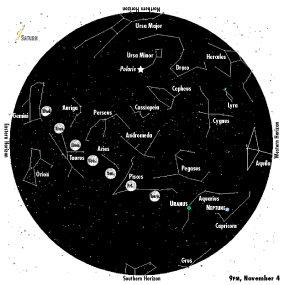 |
Sky Watch
by J. Alex Knoll
|
The Slowing
Our days are shedding light, and fast
Several days into November, Saturday’s Hunter’s Moon falls late this year, as we are already nearer to winter than to summer past. The fields are empty, and in the forests, the trees are losing their leaves. Racing against the onset of winter weather, hunters through the ages have used the added light of this moon to in pursuit of game to fill their stores with as much meat as possible.
As trick-or-treaters prowled the streets, unbeknownst to them, the earth crossed a pivotal point in its yearly trek around the sun. During autumnal equinox some six weeks ago, the sun shone from a spot directly above the equinox. By winter solstice December 21, the sun will have dipped south more than 20 degrees, hovering above the Tropic of Capricorn. Between the equinoxes and the solstices fall the four cross-quarter days.
Halloween, or in some cases November 1, marks one of these cross-quarter days, what pre-Christian tribes in Britain and Europe celebrated as the new year, Samhain. Crops were harvested and stored away for the winter; livestock was brought in from pasture, either to shelter or to slaughter; bonfires lit the night amid dancing and celebration for the year’s bounty and prayers for a short and mild winter.
Although the solstices and equinoxes dissect the year into four equal seasons, the play of light and dark within those periods is skewed by earth’s elliptical orbit and its tilted axis. As a result the days and nights nearest the spring and fall cross-quarter days see the most pronounced gain and, as in our case, loss of daylight. In the past four weeks alone, we’ve lost 30 minutes of light in the morning and another 35 at day’s end. Between this week and next, we’ll lose 10 minutes at dawn and nearly as much at dusk. It’s just the opposite come spring, as the days rapidly grow longer in what’s called the quickening. So what we’re experiencing as we dig in for the long nights of winter is the slowing.